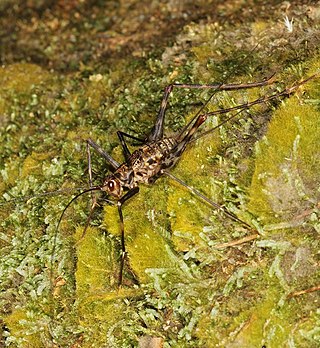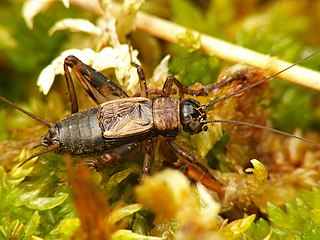
The family Gryllidae contains the subfamilies and genera which entomologists now term true crickets. Having long, whip-like antennae, they belong to the Orthopteran suborder Ensifera, which has been greatly reduced in the last 100 years : taxa such as the spider-crickets and allies, sword-tail crickets, wood or ground crickets and scaly crickets have been elevated to family level. The type genus is Gryllus and the first use of the family name "Gryllidae" was by Francis Walker.

Trigonidiinae is a subfamily of insects in the order Orthoptera, suborder Ensifera, based on the type genus Trigonidium. They are often referred to as sword-tail crickets, winged bush crickets or trigs.

Phalangopsinae, occasionally known as spider crickets, are a subfamily of crickets in the family Phalangopsidae. Members of Phalangopsinae are found worldwide in tropical and subtropical regions. Most species in the subfamily are nocturnal and can be found in rocky areas, near fallen wood, and the understory of forests. Some species are gregarious, gathering in large numbers.

The Eneopterinae are a subfamily of crickets, in the family Gryllidae, based on the type genus Eneoptera. It is one of several groups widely described as "true crickets". Of the more than 500 species that make up this subfamily, most occur in moist, tropical habitats. These insects are medium to large and brown or gray in color. They eat plant leaves, flowers, and fruits and can occasionally cause economic damage. Their eggs are deposited in pith, bark, or wood. Eneopterinae show a great diversity in stridulatory apparatus, signals emitted, and associated behaviour.

Mogoplistidae is a family of scaly crickets within the superfamily Grylloidea. Considered to be monophyletic, a sister taxon to the Gryllidae crickets. This family consists of more than 370 species worldwide; 20 species in 4 genera occur in North America and this family includes the scaly crickets of Europe.

Nemobiinae is a subfamily of the newly constituted Trigonidiidae, one of the cricket families. The type genus is Nemobius, which includes the wood cricket, but members of this subfamily may also be known as ground crickets or "pygmy field crickets".

Homoeogryllus is a genus of cricket in the subfamily Cachoplistinae and tribe Homoeogryllini. The recorded distribution is: Africa and Peninsular Malaysia.

Podoscirtinae is a subfamily of crickets in the family Gryllidae.

The Phalangopsidae are a recently reconstituted family of crickets, based on the type genus PhalangopsisServille, 1831 from South America. Priority for family-group names based on this genus dates from Blanchard's "Phalangopsites".
The Phaloriinae is a subfamily of crickets of the family Phalangopsidae. Species are terrestrial and are distributed in: Africa, tropical Asia, Korea, Australia and the Pacific Islands.
Trellius is an Asian genus of crickets in the family Phalangopsidae, subfamily Phaloriinae, tribe Phaloriini.
Micrornebius is a genus of crickets in the subfamily Mogoplistinae, tribe Mogoplistini.
The Euscyrtinae are a subfamily of crickets, in the family Gryllidae, based on the type genus Euscyrtus. They are terrestrial and omnivorous and can be found in: Central America, Africa, Asia and Australia.
The Landrevinae are a subfamily of crickets, in the family Gryllidae, based on the type genus Landreva. They are terrestrial, omnivorous and may be known as "bark crickets"; genera are distributed in: Central and South America, Africa, tropical Asia, Korea, Japan, Australia and the Pacific Islands.
Eutachycines is a genus of cave or camel crickets in the subfamily Aemodogryllinae and tribe Aemodogryllini. Originating in Asia, species have been found in Sri Lanka, southern China, Indo-China and west Malesia.
Sclerogryllus is an Asian genus of crickets, typical of the subfamily Sclerogryllinae and the only genus in the tribe Sclerogryllini.

Modicogryllini is a tribe of crickets of the family Gryllidae. Species are terrestrial, carnivorous or omnivorous and can be found in all continenents except Antarctica.
Sonotrella is a genus of crickets in the subfamily Podoscirtinae and tribe Podoscirtini. Species have been recorded in: southern China, Indo-China and west Malesia.
Zvenella is a genus of crickets in the tribe Podoscirtini. Species have been recorded in: southern China, Indochina and Sumatra.
Trelleora is a genus of crickets in the tribe Podoscirtini. Species have been recorded in: India, southern China and Indochina.








